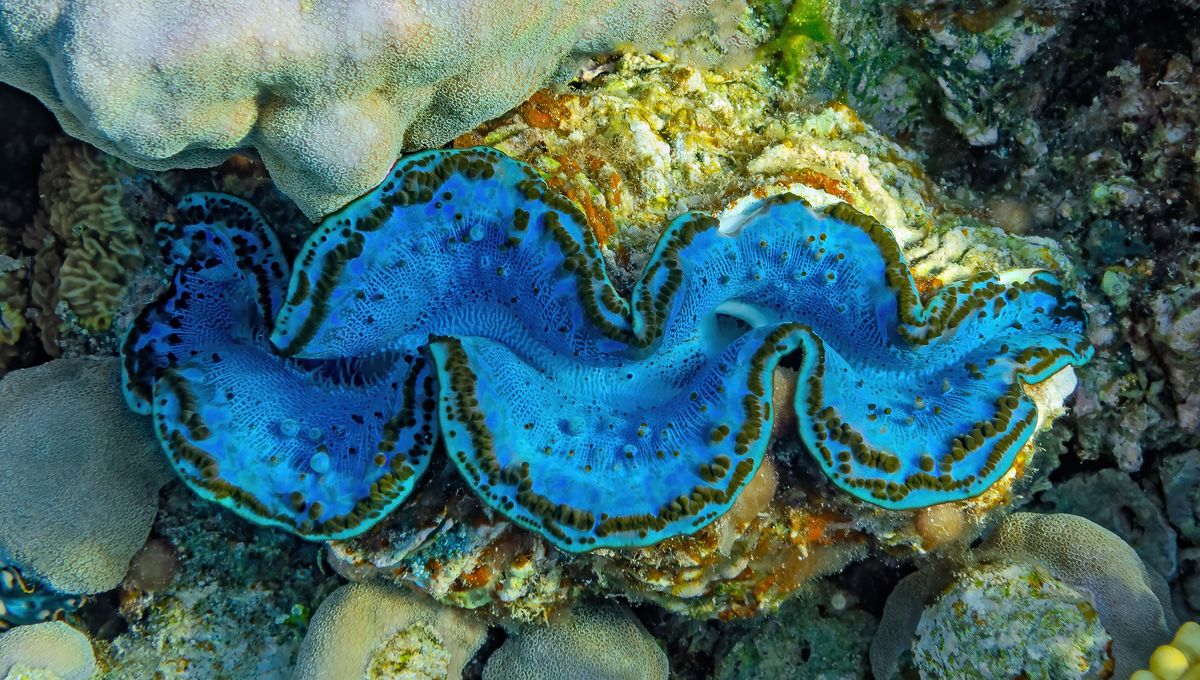To Make A Better Solar Cell Consult A Giant Clam – IFLScience
Giant clams have a thin light-scattering layer that covers symbiotic photosynthetic algae, allowing their companions to capture more sunlight. This and other unexpected tricks probably make the clam-algae combination the most efficient sunlight harvesters on Earth. Since holding onto more sunlight is among the major technological challenges of our age, the clams might have a lot to teach us.
Giant clams have worked out that sunlight offers a lot of free energy. Although they cannot harvest the light directly themselves, they play host to microalgae that do, and exchange nitrogen and other nutrients for energy-carrying molecules, reaping much of the benefit.
A similar arrangement has led to the formation of coral reefs, but the clams have taken things a step further. Instead of leaving the symbiotic single-celled organisms to capture the sunlight themselves, clams lend assistance.
The clams’ algae form themselves into vertical columns. Living in the tropics, where the Sun is almost directly overhead in the middle of the day, means the columns are often growing parallel to the light. On its own, this would be quite an inefficient system, some algae would get too much light, others too little.
However, the clams provide assistance in the form of a layer of iridescent crystal-rich cells known as iridocytes, which scatter the sunlight in ways that make it optimal for the algal columns. A consequence of this is that the insides of the clams are very dark – so much light is captured almost none bounces back to be seen.
Dr Alison Sweeney is one of the few people suited to investigate both sides of this process. She is an associate professor of ecology and evolutionary biology at Yale University and of physics at the same institution. She’s been exploring the way organisms make use of physics since her PhD on squid optics.
Sweeney and co-authors conclude that 67 percent of the energy in the light falling on a giant clam is converted into chemical energy. That contrasts with a little over 20 percent of sunlight becoming electrical energy in the best mass-produced solar cells, with experimental versions battling to get to 30 percent. No other measured living system can match it. Tropical rainforest leaves manage 14 percent. Major crops utilize just 3 percent, part of the reason most biofuels have failed. “The thing that comes closest is boreal spruce forests,” Sweeney noted in an interview three years ago. Even after sharing some of that energy with the algae, that leaves the clams pretty happy.
Sweeney noted that the clams and spruce have hit on a similar solution. Rather than placing the light receptors perpendicular to the sunlight, as solar panels and most plants do, light is scattered onto pillars growing parallel to its original direction. Spruce achieve this by growing within a cloudy haze that does the scattering, while the clams use their iridocytes for a more targeted redirection.
Like a field of sunflowers following the Sun, clams also adapt themselves to the direction of the light. “Clams like to move and grove throughout the day,” Sweeney said in a statement. “This stretching moves the vertical columns farther apart, effectively making them shorter and wider.” Without this, clams and algae would catch 43 percent of the energy – much lower but still better than almost anyone else.
Team clam-algae are approaching a theoretical maximum in their energy harvesting, but there might be others no one has thought to check that get closer still.
“My colleagues and I continue to brainstorm about where else on Earth this level of solar efficiency might happen. It is also important to recognize we can only study biodiversity in places where it is maintained,” Sweeney said. She credits the population of Palau with protecting their clams from over-harvesting and environmental damage, enabling her research.
Today, saving such biodiversity, clams included, depends on finding better energy-harvesting systems that don’t emit carbon dioxide. The costs of solar cells have fallen so far that installation and the land on which they are placed are becoming major factors in the price. More efficient cells mean more power produced from the same area, potentially making solar even more competitive with fossil fuels.
Just how this could be done is not yet clear, but Sweeney said: “One could envision a new generation of solar panels that grow algae, or inexpensive plastic solar panels that are made out of a stretchy material.” More immediately, Sweeney and co-authors suggest the clam’s techniques could be used to improve the yield of microalgae grown for biofuels.
Sweeney is far from the first to recognize that evolution is often way ahead of the most advanced human engineers. The field of biomimicry has a long history of applying the lessons of nature to build better technology from drawing water from the air to wall-climbing robots.
The study is open access in PRX Energy.


